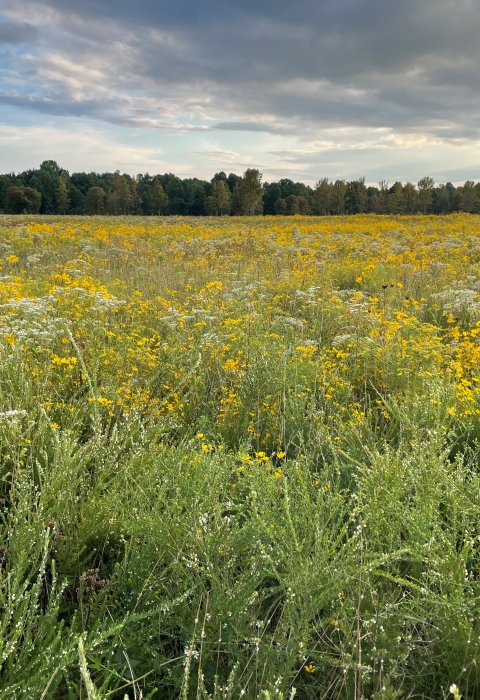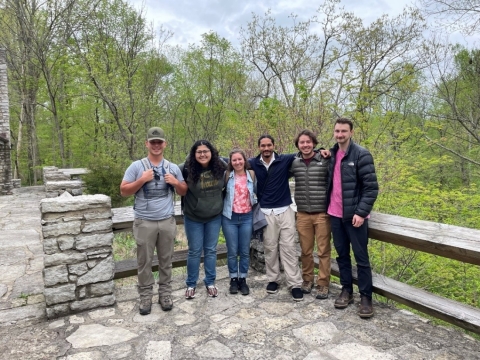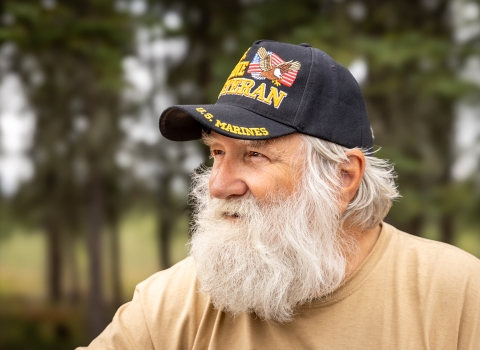By Gabriel Van Praag, Daniel Asyn, Ashley Garcia, Lane Lopez, Denna Martinez, and Ben Newman
Climate change presents a growing threat not just to species protected by the Endangered Species Act but to all fish, wildlife, plants, and their habitats. The fellows of the new Civilian Climate Corps Fellowship saw these threats as they worked and lived at Aransas National Wildlife Refuge, Big Oaks National Wildlife Refuge, Bosque del Apache National Wildlife Refuge, Santee National Wildlife Refuge, Willapa National Wildlife Refuge, and Yukon Flats National Wildlife Refuge. And they developedstrategies to help land managers adapt to the changing climate.
Jimmy Fox, project leader at Yukon Flats National Wildlife Refuge, is a fan.
"It's been very helpful to have a Civilian Climate Corps fellow working with refuge staff to help us understand how natural features of the refuge are changing and what the future may hold for this place. This work gives us something to bring to conversations with Tribes who are concerned about the future."
Seeing the Problems
Aransas, along the mid-Texas coast, provides habitat for migratory waterfowl and for the endangered whooping crane. There, projected increases in sea level rise are expected to impact low-lying marshes by increasing saltwater intrusion and exacerbating storm surge, especially during tropical storm events.
Also along the coast, though in southwestern Washington, Willapa encompasses tidal wetlands, coniferous old-growth forests, coastal dunes, and coastal prairies. The increases in temperature from climate change climate change
Climate change includes both global warming driven by human-induced emissions of greenhouse gases and the resulting large-scale shifts in weather patterns. Though there have been previous periods of climatic change, since the mid-20th century humans have had an unprecedented impact on Earth's climate system and caused change on a global scale.
Learn more about climate change will likely causefire frequency to rise, putting many sensitive rainforest species at risk.
In the northeast interior of Alaska, Yukon Flats Refuge, the third largest of the Refuge System, is on the forefront of climate changes. Yedoma, an old ice rich permafrost, underlies parts of the refuge. The effects from warming temperatures and wildfire can influence permafrost thaw, which can alter the landscape and release carbon. The refuge’s brackish wetlands have some of the highest densities and diversity of waterbirds on the refuge, but they are vulnerable to warming temperatures.
Sitting alongside the Rio Grande in New Mexico, Bosque del Apache manages its wetlands, riparian riparian
Definition of riparian habitat or riparian areas.
Learn more about riparian forest, semi-arid grassland, and desert scrub habitat for migratory and wintering waterfowl and for four federally protected species. The increasingly arid climate of the region is of great concern. The changing climate’s warming trend is also exacerbating droughts and reducing water availability, thus creating problems for the creation of wetland habitat for the waterfowl.
Also providing habitat for wintering waterfowl, Santee is in the coastal plains of South Carolina. Higher temperatures and changing precipitation regimes may affect the timing of migration, and of optimal emergence of needed resources and breeding conditions for migratory and residential species.
Farther north and inland, Big Oaks, in southeastern Indiana, is a globally important bird area thanks to its large grassland habitat while also protecting one of the largest continuous blocks of forest in the state. These grasslands will continue to depend on the use of prescribed fire to keep back woody encroachment, though it is uncertain how the use of fire will be affected by the higher temperatures and increases in precipitation caused by climate change. The climatic stress from these extreme heat and rainfall events, as well as increasing invasive plant pressure, could also lead refuge forests to face changing understory composition.
To put together this list of potential and current problems, fellows gatheredprojections of management and locally relevant climate variables such as temperature, precipitation, extreme rainfall events, and sea level rise. To understand the plausible range of future climatic conditions, they selected values from several timeframes (mid-century, late century) and from differing greenhouse gas emission scenarios. Fellows performed extensive literature reviews and consulted with subject matter experts to determine the potential impacts of the previously selected climate variables under several climate scenarios.
Potential Solutions
The fellows took this climate change data and research and applied it to natural resource management and decision-making. They assessed the vulnerability of priority resources on refuges, identified plausible trajectories of ecosystem change, and provided adaptation recommendations.
Their project looked beyond traditional management strategies that consider baseline conditions as the ideal state. Climate change is causing ecosystems to shift away from historical baselines, resulting in changes in unexpected ways. Species may shift their ranges or change their migration timing. Habitats may transform gradually or undergo rapid transitions into novel systems. Therefore, fellows guided the development of adaptation strategies using the Resist-Accept-Direct decision-support tool. Strategies explicitly state whether their objective is to “resist” and maintain or restore historical conditions, “accept” ecosystem transformation, or “direct” change toward a desirable new state. These drafted strategies are not prescriptive, as managers could choose different approaches across space and time as the change unfolds.
Fellows’ assessments provided an array of strategies and actions managers will be able to choose from to adapt to localized climate change impacts. Active management, such as increasing structural and compositional diversity, could be chosen to mitigate climate threats and resist changes whenever feasible. Low-risk planting of future-adapted seeds of important plant species could be performed to increase a site’s adaptability to the future climate.
Fellows also developed monitoring recommendations as changes to species and habitats will unfold in unexpected ways. For instance, they recommended implementing Surface Elevation Tables to monitor marsh accretion rates, surveying for new invasive species invasive species
An invasive species is any plant or animal that has spread or been introduced into a new area where they are, or could, cause harm to the environment, economy, or human, animal, or plant health. Their unwelcome presence can destroy ecosystems and cost millions of dollars.
Learn more about invasive species , and using remote sensing to track structural ecosystem changes.
The National Wildlife Refuge System’s Natural Resource Program Center, which provides scientific support to national wildlife refuges throughout the nation, developed the Civilian Climate Corps Fellowship with the Hispanic Access Foundation Mano project.
Although just the first program of its kind, fellows hope their work can serve as a model for Service managers seeking to use climate science to inform local decision-making. Even though these assessments were tailored toward specific refuges, some of the compiled climate projections and literature reviews may be of use at other field stations. Additionally, the methodology followed and lessons learned from the work could help inform the project design and implementation of future climate assessments. Helping bridge the gap between climate change research and local implementation, these assessments highlight practices that will aid in further progressing local climate change adaptation.
By Gabriel Van Praag, Daniel Asyn, Ashley Garcia, Lane Lopez, Denna Martinez, and Ben Newman, Civilian Climate Corps Fellows





